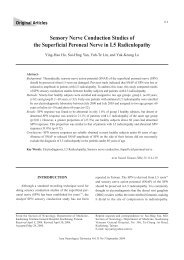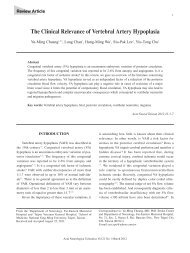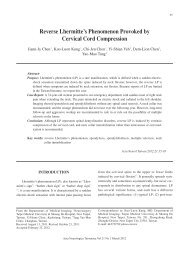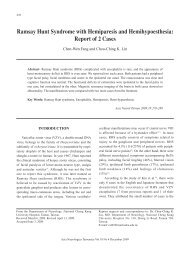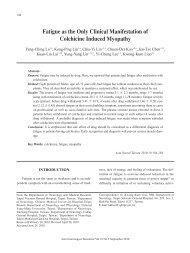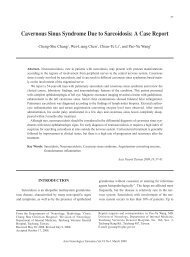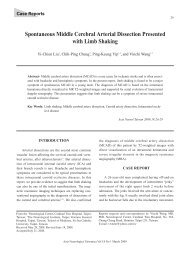Overwork, Stroke, and Karoshi-death from Overwork - Ant
Overwork, Stroke, and Karoshi-death from Overwork - Ant
Overwork, Stroke, and Karoshi-death from Overwork - Ant
Create successful ePaper yourself
Turn your PDF publications into a flip-book with our unique Google optimized e-Paper software.
studies in the United States <strong>and</strong> Japan found positive<br />
association between over-time work, shift work, <strong>and</strong><br />
long-travelling time to work <strong>and</strong> cardiovascular diseases<br />
(2,7,8,9) . Studies in Europe found that low reward jobs,<br />
shift work, <strong>and</strong> working at night increased risk of cardiovascular<br />
diseases (10,11,12) .<br />
<strong>Karoshi</strong>, <strong>death</strong> <strong>from</strong> overwork, is a social medicine<br />
term first appeared in Japan in late 1970 (13,14) . The first<br />
reported case of karoshi was in 1969 with a stroke <strong>death</strong><br />
of a 29-year-old male worker in the shipping department<br />
of Japan’s largest newspaper company (13) . It was not until<br />
the later part of the 1980s when several business executives<br />
who were in their prime years suddenly died without<br />
any previous sign of illness. This new phenomenon<br />
attracted media’s attention in Japan, <strong>and</strong> was quickly<br />
labeled karoshi, denoting a novel <strong>and</strong> serious menace for<br />
people in the work force (13) . <strong>Karoshi</strong> is occupational sudden<br />
<strong>death</strong>. The major medical causes of karoshi <strong>death</strong>s<br />
are heart attack <strong>and</strong> stroke due to stress (13) . There are<br />
Taiwanese social scientists retrospectively reviewed the<br />
developmental process of Japanese industry <strong>and</strong> enterprise<br />
(15,16,17) . They tried to explore factors associated with<br />
karoshi events <strong>from</strong> social science viewpoint. They have<br />
found two major factors associated with karoshi: 1. long<br />
working hours; 2. too much work stress. They also found<br />
that workers working with irregular duty hours, taking<br />
new jobs without family members around, working at<br />
night, <strong>and</strong> piecemeal jobs are associated with increased<br />
risk of karoshi. Furthermore, business <strong>and</strong> union leaders<br />
did not pay attention to the impact of work stress on<br />
Table 1. Major medical causes of <strong>death</strong> <strong>and</strong> symptoms <strong>and</strong> signs in karoshi<br />
Acta Neurologica Taiwanica Vol 21 No 2 June 2012<br />
55<br />
karoshi, <strong>and</strong> this ignorance has contributed to the<br />
increase of karoshi in Japan.<br />
Responding to the increased attention <strong>and</strong> awareness<br />
to karoshi, the Japanese Ministry of Labor began to publish<br />
statistics on karoshi in 1987 (13) . Many companies,<br />
such as Toyota, have working hour policy to limit overtime<br />
work <strong>and</strong> stressed the importance of rest <strong>and</strong> urging<br />
workers to go home. Moreover, governments, including<br />
Japan <strong>and</strong> Taiwan, have faced increasing pressure <strong>and</strong><br />
finally set legal criteria of karoshi for worker compensation.<br />
Taiwanese government passed the guideline for<br />
establishing occupational cardiovascular <strong>and</strong> cerebrovascular<br />
diseases in 1991 <strong>and</strong> revised in 2004 <strong>and</strong> in 2010.<br />
Table 1 described major medical causes of <strong>death</strong> <strong>and</strong><br />
symptoms <strong>and</strong> signs of karoshi (13,18) . Most frequent medical<br />
causes of <strong>death</strong> are acute heart failure <strong>and</strong> subarachnoid<br />
hemorrhage. People under overwork stress may<br />
present with no obvious symptoms <strong>and</strong> signs of heart<br />
<strong>and</strong>/or brain problems but with depression <strong>and</strong>/or<br />
burnout syndrome (18) . Death <strong>and</strong> suicide due to overwork<br />
has been reported as new occupational threats to<br />
Japanese physicians (18) .<br />
Stress hormones in health <strong>and</strong> illness: the role<br />
of work<br />
Two neuroendocrine systems would be of specific<br />
interest in the study of health impact <strong>from</strong> stress (19) . The<br />
sympathetic adrenomedullary system secrets two catecholamines,<br />
epinephrine <strong>and</strong> norepinephrine, <strong>and</strong> the<br />
hypothalamic pituitary adrenocortical system secrets<br />
Major medical causes of <strong>death</strong> (%) (13) SAH*(18.4%)<br />
Cerebral hemorrhage (17.2%)<br />
Cerebral infarction (6.8%)<br />
Myocardial infarction (9.8%)<br />
Heart failure (18.7%)<br />
Other causes (29.1%)<br />
Pre-event condition (18) Common symptoms <strong>and</strong> signs<br />
Burnout symptoms Easy fatigue, forgetful, tight neck <strong>and</strong> shoulder, headache, myalgia, chest tightness,<br />
body weight change.<br />
Depression Poor concentration, feels blue easily, insomnia, suicide idea or attempt<br />
*SAHsubarachnoid hemorrhage



